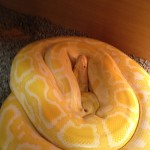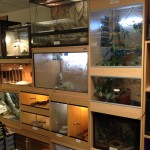How to treat snake mites – one method out of many

There are many ideas on how to treat snake mites. Most have their own merits and most have there own drawbacks. I have used a few of these and have had success removing the mites but have also had less desirable results as well. The only method I have used where the downside is much less than the up is the one I am going to outline here.
If you have a lot of snakes (a breeder or just lucky enough to have a large collection) you may find the main drawback of this method of how to treat snake mites a little to much for you. Basically it takes a bit more time than other methods. However it’s the safest I have found.
To illustrate the method of how to treat snake mites I am going to use a real example of an extreme infestation. The snake in question was very weak and in considerable distress and had been for some time. There were other factors involved concerned with poor care but I am going to concentrate on how to treat snake mites so I will leave those to one side for now.
I will mention other methods of how to treat snake mites I have tried or where I have heard of others that have tried them. I will outline what I have found to be the downsides of these other methods of how to treat snake mites and of the method I use. Whichever method you decide to use is your choice and no doubt will be based on your own particular set of circumstances. I am not saying my method is the best for everyone but it is the best for me and you may want to try it too.
- Firstly if your snake is badly infested (if it is – why have you let it get that bad?) you need to give it a bath in warm water to get the bulk of the little buggers off. Actually this is not first. First you need to make sure you don’t have long sleeves on or a woolly jumper. You don’t want them getting caught up in your clothing and spreading to someone else’s collection (especially mine – alright!). Once you are correctly attired give the snake a bath. Most snakes (all the ones I have come across) are OK with being bathed. I use something like a RUB or large cat litter tray and do it outside of the shop. Let the snake have a good old soak and then run your hands down its body from head to tail over the water to get off the ones disturbed by the dunking and let the little sods drown. In my example of how to treat snake mites I had to change the water twice! My hands were black with dead mites.
- Once you have done this, dry the snake in some paper towel. Dispose of this immediately, live mites will come off on it. Your snake is now ready for treatment.
- If you have a spare RUB or similar, secure plastic tub I would use this. If not, it isn’t essential. I use Zoo Med Mite Off to treat the actual snake. I have heard people say that it’s not effective. However this is because it has not been used correctly. You will be very lucky to get away with only one treatment. Usually it takes two or three. The most I’ve had to use was four on a particularly stubborn case on a common boa I rescued.
- Spray the snake from head to tail, be quite liberal. The benefit of Mite Off over other treatments is that I have not heard of a single substantiated case of it harming the snake, even with neonates. Because of this you can use it around those stubborn areas near the eyes and corners of the mouth. Run the snake through your, now wet, hands a few times. If you can see any mites pick them off and pop them or drown them in some water. I prefer to pop them, it’s quite satisfying, it’s my favourite part of this method of how to treat snake mites.
- Once the treatment is complete, put the snake in the RUB lined with some paper towel with just a water bowl and put to one side. Clean up the area you have been working in and throw away any soiled towels. If I were you I’d throw them in the dustbin outside, not in the kitchen bin – just to be on the safe side.
- Now turn to the vivarium. Take out everything that isn’t fixed down. I would strongly suggest, if you can afford to, that you throw away any wooden items. Alternatively you can freeze them overnight or cook in the oven for an hour (if they will fit). This will stink out the house for a while though – you have been warned. This will also kill off any mites hiding in the crevices. Empty out the substrate and throw it away. Bleach any water bowls. The next stage is critical to this method of how to treat snake mites.
- I have found the best thing to treat the vivarium itself is isopropyl alcohol. It can be ordered from your pharmacy. Pour some on some paper towel and wipe it over every surface in the viv. If you have fittings that you cannot remove make sure you get some into any edges and under any mountings. The effect of the alcohol is to dry out any mites and importantly, their eggs. Be thorough.
- The benefit of using isopropyl alcohol in this method of how to treat snake mites over other treatments is, apart from its effectiveness, it leaves no residue, evaporates very quickly and has no toxic fumes. The disadvantage is that it does require a bit more effort compared to alternatives.
- I have also used Callington mite spray and this is effective. However I lost two young garter snakes shortly after putting them back in the viv. I left the viv. to ventilate for several hours before putting them back but two of the three snakes clearly had their nervous systems poisoned. They started fitting and died fairly quickly. I asked around and initially couldn’t find any other instances of this. However since then a well known breeder has told me that he has lost some snakes after using Callington. He was using it directly on the snakes, which he has been doing for years without incident, and has now stopped using it. The snakes he lost were also quite young so I think it prudent to only use this product with older snakes and only as a viv. treatment. Customers do use it but it’s not my favourite method of how to treat snake mites.
- This same breeder has routinely used Ardap for his vivs. on an annual basis. However this year, following his routine treatment, which takes him all day, he lost six snakes. He certainly knows how to use the product and is aware of its potency. Again the snakes were , I believe, all young. I have never used Ardap, not because I disagree with its use, that’s up to you. Its because in my shop I have a large stock of spiders and other invertebrates. Using Ardap would wipe out this stock in a stroke. It would also take out the birds, fish and possibly the small mammals as well. Potent stuff. Probably not the best method of how to treat snake mites for the average hobbyist.
- Once you have treated the viv. just leave it. If you are using a RUB place it, with the snake inside, in the viv. If not, use paper towel on the bottom of the viv and replace the snake and its water bowl. Either way, check the snake in 24 hours. Replace the paper towel and pop any mites you find with your thumb nail. Check again the next day. On day three, if necessary and it probably will be, retreat the snake. You should also treat the RUB with isopropyl alcohol. If not using a RUB you will need to retreat the whole viv. again. Hence why, in this method of how to treat snake mites I suggest its best to use a RUB if you can.
- I have recently been using Bob Martin My Little Friend small animal cage disinfectant instead of isopropyl alcohol. I noticed that this product contains alcohol so I gave it a go. It appears to work just as well at a fraction of the price, is readily available (to me – I stock it in my shop) and has had no ill effects on the snakes. However I have only used this a couple of times so far. I have now incorporated it into my method of how to treat snake mites though.
- Go through the checking process again and retreat if necessary. Keep going until there are no signs of mites. The most treatments I have had to do was four and the fourth was possibly not necessary. this method of how to treat snake mites does require you to follow through all the actions though, miss a step and you are wasting your time.
- One other method I have used is Frontline (fipronil) flea treatment on the snake and alcohol on the viv. This worked very well but you must take out the water bowl for at least 24 hours and I wouldn’t feed the snake for a few days. Don’t use this method on neonates. I have read it is too strong for them, although because I knew this I didn’t use it in these circumstances so, I am pleased to say, I haven’t any direct experience of that.I no longer use this method of how to treat snake mites though as it is more expensive and just not necessary. Fibronil is now more widely available now though, so the price has come down. The Frontline brand is still expensive.
I have left off discussing predatory mites for two reasons. Firstly I have no direct experience of this method of how to treat snake mites (you buy another, predatory species of mite that eats the snake mites). Secondly I do not use the right sort of substrate in my snake vivs. You need a more soil type substrate for the predatory mites to thrive. Apparently you just chuck ’em in, they go to work chomping on your snake’s mites and then die off when there’s no food left. Neat huh.
When I next get a snake with mites in the shop (we sometimes rescue snake) I will make a video showing how to treat snake mites based on this method. You will be able to see it on our YouTube channel. Subscribe now and receive notification when it’s posted.
So there you go. Zoo Med mite off on the snake and isopropyl alcohol on the viv. is how to treat snake mites safely. Well, its how I do it and it’s always worked with no side effects and that’s what you want, isn’t it.?
Good luck
The Angell Pets Team
 If you think your child’s interest in animals is a passing phase then a shorter lived species is better. Then you are not left looking after an animal no one is interested in anymore (not fair on the animal). If you want to avoid the stress of a death in the family whilst your child is still young go for something a bit longer lived. This is a very important aspect of choosing the right pet. Children grow up and leave home. Are they going to be able to take their pets with them into digs at university or rented accommodation? If not, be prepared to look after it when they are grown up and gone. In some cases (tortoises and parrots for example) your child is going to have to consider who they are going to leave the animal to when they are gone, as it will outlive them.
If you think your child’s interest in animals is a passing phase then a shorter lived species is better. Then you are not left looking after an animal no one is interested in anymore (not fair on the animal). If you want to avoid the stress of a death in the family whilst your child is still young go for something a bit longer lived. This is a very important aspect of choosing the right pet. Children grow up and leave home. Are they going to be able to take their pets with them into digs at university or rented accommodation? If not, be prepared to look after it when they are grown up and gone. In some cases (tortoises and parrots for example) your child is going to have to consider who they are going to leave the animal to when they are gone, as it will outlive them.



